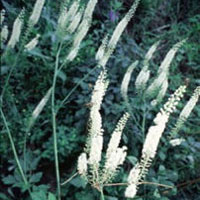Black Cohosh
 © Steven Foster
© Steven FosterHow It Works
Black cohosh contains a few ingredients, including triterpene glycosides (for example, acetin and 27-deoxyactein) and isoflavones (for example, formononetin). Other constituents include aromatic acids, tannins, resins, fatty acids, starches, and sugars. As a woman approaches menopause, the signals between the ovaries and pituitary gland diminish, slowing down oestrogen production and increasing luteinizing hormone (LH) secretions. hot flushes can result from these hormonal changes. Earlier animal studies4, 5 and a human clinical trial6 suggested that black cohosh had some estrogen activity in the body and also decreased LH secretions. However, more recent animal studies7 and a clinical trial8 have found no oestrogen activity for black cohosh extracts. Further clinical trials are needed to determine whether black cohosh has significant oestrogenic actions in the body.
Small German clinical trials support the usefulness of black cohosh for women with hot flushes associated with menopause.9, 10 A review of eight clinical trials found black cohosh to be both safe and effective for symptomatic relief of menopausal hot flushes.11 Other symptoms which improved included night sweats, insomnia, nervousness, and irritability. A clinical trial compared the effects of 40 mg versus 130 mg of black cohosh in menopausal women with complaints of hot flushes.12 While hot flushes were reduced equally at both amounts, there was no evidence of any oestrogenic effect in any of the women. Although further trials are needed, this trial suggests that black cohosh is best reserved only for the symptomatic treatment of hot flushes associated with menopause and is not thought to be a substitute for hormone replacement therapy in menopausal and postmenopausal women.
A recent study suggests black cohosh may protect animals from osteoporosis.13 Human studies have not confirmed this action.
How to Use It
Black cohosh can be taken in a few forms, including crude, dried root or rhizome (300–2,000 mg per day), or as a solid, dry powdered extract (250 mg three times per day). Standardised extracts of the herb are available. The recommended amount is 20–40 mg twice per day.14 The best researched extract provides 1 mg of deoxyactein per 20 mg of extract. Tinctures can be taken at 2–4 ml three times per day.15 According to the German Commission E Monographs, black cohosh can be taken for up to six months, and then it should be discontinued.16
Copyright © 2024 TraceGains, Inc. All rights reserved.
Learn more about TraceGains, the company.
The information presented by TraceGains is for informational purposes only. It is based on scientific studies (human, animal, or in vitro), clinical experience, or traditional usage as cited in each article. The results reported may not necessarily occur in all individuals. Self-treatment is not recommended for life-threatening conditions that require medical treatment under a doctor's care. For many of the conditions discussed, treatment with prescription or over the counter medication is also available. Consult your doctor, practitioner, and/or pharmacist for any health problem and before using any supplements or before making any changes in prescribed medications. Information expires December 2024.



 We are proud to announce that
We are proud to announce that  As the market evolves, customers increasingly request a wider variety of omega-3 options for their lipid...
As the market evolves, customers increasingly request a wider variety of omega-3 options for their lipid...  Maintaining healthy glucose levels is crucial for preventing metabolic conditions like diabetes,...
Maintaining healthy glucose levels is crucial for preventing metabolic conditions like diabetes,...  Looking at formulating a new vitamin blend? Discover
Looking at formulating a new vitamin blend? Discover 







































